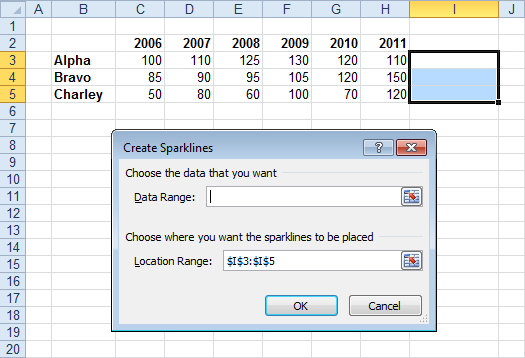
If you hold the Alt key while dragging a picture, it will snap to the nearest cell border. The biggest challenge is probably to align the two images perfectly. Here’s the Combination Column / Line Chart: In the example, I changed the Height from 104% to 105% and the ragged line in this screenshot was restored. If the line in the image looks a bit ragged, open the Format Picture dialog and on the Size tab adjust the Height and/or Width by a percentage point. The steps are the same as above, but this time the front picture has been taken from a Line Sparkline. Since the background of the Red picture is also transparent, the taller blue columns will peek out above the red columns, thus effectively creating a Stacked Column Sparkline. The Blue one is in the background and the Red one is in front. Now drag the two pictures on top of each other. The transparent picture background is essential for the next step to work, so make sure not to use fill colors in the Red Sparkline cell. Repeat the Copy Picture process for the Red Sparkline, paste it and link it to the Red Sparkline cell. This is because the source cell has no color fill. Note that the picture has a transparent background (you can see the Excel grid in the background). Now the picture is dynamic and will show whatever content is in that cell. To make it dynamic, select the picture, then click into the Formula bar, enter a = sign and click on the cell that has the Helper Sparkline.
CREATE SPARKLINES IN EXCEL 2010 UPDATE
This is a static picture and will not update when the Sparkline changes. Next, select the cell with the Helper Sparkline and use the Copy drop-down on the Home tab and copy the cell as a picture, accepting the default in the Copy Picture dialog. Set the Vertical Axis Minimum Value to a Custom Value (in the example it is 0 ) and the Vertical Axis Maximum to a Custom Value (in the example it is 10).Ĥ.

Select all three Sparklines, click the Design tab of the Sparkline Tools and select the Axis drop-down. We need to ensure that all three Sparklines have the same Y axis settings. Then create a Helper Sparkline which shows the newly summed data. To achieve that, first go to the data table and add a helper column that sums the values of Blue and Red. The goal is to create a Sparkline that stacks the blue columns onto the red ones.

The source data in this example is arranged in a table with two columns, Blue and Red. Start out with two Sparklines, Blue data and Red data. What it does not offer is a way to create stacked column charts or combination charts with columns overlaid by a line.īut with a bit of preparation and few tools from the trick box, it can be done. Sparklines have been introduced with Excel 2010 and are a useful tool for creating small in-cell charts, used for example in dashboards.Įxcel 2010 offers three different types of Sparklines: Line, Column and Win/Loss.


 0 kommentar(er)
0 kommentar(er)
